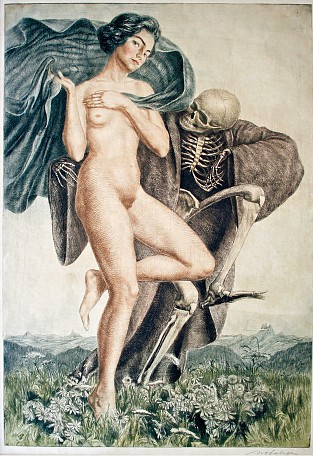Ivo Saliger: Death and Girl
Atem(be)raubend
Ivo Saliger
Death and Girl
around 1920
color etching; 65 x 48 cm
The Graphic Collection of the Museum for Sepulchral Culture includes an etching by the painter and graphic artist Ivo Saliger, who was born in Königsberg in 1894 and died in Vienna in 1987. Its depiction ties in with the traditional dance of death theme and the motif "death and girl" extracted from it. Characteristic of this motif, which was created as early as the 16th century, is its sometimes rather crude erotic component: the bone man eagerly approaches the female body, which is sometimes depicted completely naked. Femininity is seen as an expression of life, of sin and thus also of earthly transience. While "Death and the Maiden", along with other sequences of images from the Dance of Death, are still presented today as adequate artistic subjects for the depiction of inevitable death in the sense of a memento mori, Saliger's motif may also be a compensation for his own personal grief.

Ivo Saliger created a similar etching with the motif "Death and Girl", supplemented by the depiction of a doctor, in June 1920. Later, in a letter, Saliger gave the long history of his sister's illness and her death in April 1920 as the motivation for this. The etchings "Death banishing X-ray irradiation", "Deathfight" and "The Doctor" also date from this creative period. Regardless of the theme of "death," nudes, along with landscape and genre scenes, formed the main theme in Saliger's works. Regrettably, he thus advanced to become a preferred artist of Nazi art policy, especially since his depictions increasingly conformed to the new art propagated by the National Socialists, i.e., an art of the "Nordic-Aryan people" – a homeland art that, according to the concept of species and race at the time, did not permit any "degenerations". During the Nazi dictatorship, for example, Saliger's female figures increasingly represented the ideal of feminine beauty that had once been envisioned, with the qualities assigned to it such as vitality, a sense of duty, motherhood, and a willingness to devote oneself. Typical creative characteristics of this are the conspicuous plasticity and smoothness of female bodies, which often even appear soulless.
However, the etching presented here is (still) far removed from such a perfectionist depiction, among other things because the female figure appears nowhere near as "smooth," devoted, and offensive as it does in some of Saliger's later works, such as the 1939 oil painting "The Judgment of Paris" or the 1940 painting "The Rest of Diana." Apart from that, (personified) death is no longer part of Saliger's thematic repertoire during this period. On the whole, Ivo Saliger's artistic importance declined after the war. On the one hand, because his works in the 1930s/1940s had flattened out more and more, on the other hand, because distance was required towards an artist whose career had experienced a tremendous boost under National Socialist rule. Whether Ivo Saliger actually conformed to Nazi ideology or was "merely" a fellow traveler for the sake of his own survival and artistic creativity could never really be clarified. For this very reason, it is important to explain the background of his works - as far as can be ascertained - in order to unravel their extremely heterogeneous qualities.
Arbeitsgemeinschaft Friedhof und Denkmal e.V.
Zentralinstitut für Sepulkralkultur
Museum für Sepulkralkultur
Weinbergstraße 25–27
D-34117 Kassel | Germany
Tel. +49 (0)561 918 93-0
info@sepulkralmuseum.de








